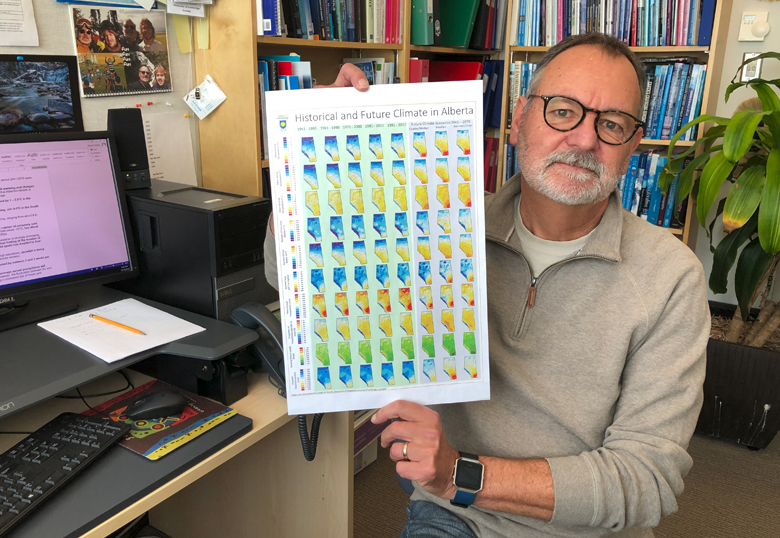As Alberta’s climate changes, the demand for practical information on climate extremes and their impact is increasing and University of Lethbridge professors, Dr. Stefan Kienzle, (Department of Geography & Environment) and Christine Clark (Department of New Media), have found a way to meet that demand.

They developed an interactive website, albertaclimaterecords.com, four years ago and have now updated it to include observed weather records from 1951 to 2017, three future climate projections (2041 to 2070), and 55 climate variables, such as number of frost days, length of the growing season and rainfall extremes. With more than 100 high-resolution maps available for download, the website is of particular interest to farmers, ranchers, foresters, water-resource managers, infrastructure planners or anyone who wants to see how Alberta’s climate has changed.
“We need to be prepared for what’s happening and this is what the website’s about,” says Kienzle. “We want to inform Albertans about what’s going on in their backyard and how our weather patterns have changed. Then anyone can at least anticipate what weather patterns are occurring in their region now and in the future and adapt accordingly.”
The updated website is designed to provide key information for climate vulnerability assessment across Alberta. Users can pinpoint a location in the province and generate a wealth of weather information for that area.
“It is clearly getting warmer in Alberta and it’s getting warmer much faster than most of the rest of the world,” says Kienzle. “The average annual temperature in southern Alberta has gone up by one-and-a-half to two degrees and by two to over three degrees in northern Alberta. Winters are the key driver of this average annual warming. They have warmed by four to five degrees in the south and by six to seven degrees in the north since the 1950s.”
The Alberta climate is also increasingly variable with more extreme weather events and warm and cold spells.
“Under global climate change, we would expect that we would have an increase in heat waves and we have that,” says Kienzle. “We have two to four times more heat waves per year compared to the 1950s. Interestingly, cold spells have also increased by a factor of two to four.”
This fall has been a prime example of that increased variability and its impact on farmers. These weather swings present more risks to farmers, whether it means harvest cannot be completed or yields are lower due to lack of precipitation or increased heat stress on crops.
The good news for growers is that the growing season is longer, creating more flexibility in seeding and harvesting, although the date of last frost has not changed significantly. Farmers also have opportunities to grow a wider variety of crops due to more heat units in the air and higher temperatures. For example, currently farmers living in the Pincher Creek area cannot grow corn now because of a lack of heat units and a shorter growing season; that could change in the future.
A new feature of the website is future climate projections. Kienzle chose three climate models most relevant to Alberta to project the climate from 2041 to 2070. For southern Alberta, those projections show even warmer temperatures, a declining number of frost days and more summer days where the temperature is 25 C or higher.
While annual precipitation is projected to increase slightly, evaporation rates will strongly increase due to higher temperatures and a longer frost-free period, resulting in overall drier soil conditions. The trend is for more rainfall to fall on fewer days, increasing the risk of flooding causing severe damage, which has occurred more frequently in recent years.

